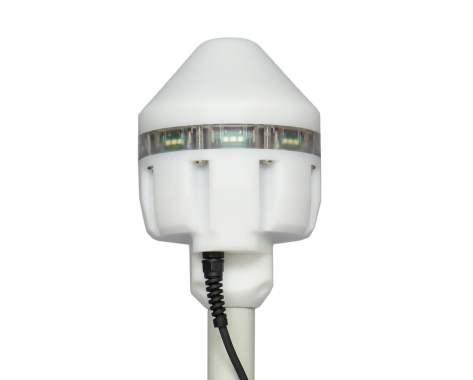Multi-band L1/L2 RTK/PPK GNSS receivers NK and FD for geophysical and hydrographic applications
We have developed NK and FD sealed and vibration-proof GNSS receivers for navigation support of offshore hydrographic and geophysical surveys. The receivers can be mounted both on the vessel and on outboard equipment, such as towed buoys for seismic streamers and electrode arrays, as well as on seismic sources such as Sparker or Boomer. Built-in radio modems provide RTK operation and real-time transmission of navigation data to the vessel.
NK GNSS system
This is the most affordable option when the positioning of a large number of onboard devices is not required, for example when performing single channel UHR seismic or marine electrical resistivity and IP surveys. The onboard receiver is equipped with a radio modem and two RS232 connectors for transmitting data from both devices to a PC. The outboard receiver can be equipped with an optional GSM modem to receive NTRIP corrections from an onshore GNSS base to ensure centimeter accuracy of positioning in real time. Both receivers continuously record raw GNSS data for post-processing kinematic (PPK). Receiving data from additional outboard receivers requires a second (paired) onboard GNSS receiver or an optional radio modem unit. The NK receiver can be supplied with external signal lights mounted on a same pole and powered by a battery with two sealed connectors.
FD GNSS system
FD receivers are equipped with built-in signal lights and provide unique scalability with a virtually unlimited number of acquisition units. The system is optimized for multi-channel 2D/3D seismic surveys where from 4 to 20 or more simultaneously operating GNSS receivers are required. In addition, the receivers can operate in Moving base mode, i.e. when the base station is installed on the vessel and the coordinates of the outboard devices are measured with centimeter accuracy relative to it. This approach allows to have two or three receivers onboard to accurately measure course and roll of the vessel, as well as for “casting” the accuracy of the vessel's “PPP” GNSS receiver to the outboard devices. Built-in radio modems provide two-way communication for receiving the correction and returning the RTK positioning back to the vessel. Navigation data reception on the PC is realized using the radio modem unit with Ethernet interface, which allows to place it in a suitable place on the vessel.
Radio modems
Different countries allow different unlicensed frequency ranges for civilian use. We use a wide range of RF modems and depending on the area of use we can equip receivers witn frequencies 433 / 868 / 900 / 915 MHz with an output power of up to 1W. The design of receivers provides easy replacement of radio modem antennas to ensure the necessary communication range.
- Any of the developed receivers can be used in Base (fixed installation on land) or Rover modes.
- Power supply of the NK/FD GNSS receivers as well as external signal lights units are provided by sealed batteries with capacity of 95 Wh. They can be transported by any transportation without any problems and have a capacity of at least 5 days of autonomy. If you need more autonomy, we can offer even more powerful batteries.
- All receivers are vibration-proof - the electronics are literally suspended on an elastic "skirt" in a spacious housing.
- External signal lights are equipped with photodetector for automatic switching on/off. Operation mode of built-in lights in FD receivers can be not only programmed by time, but also controlled directly from the vessel via radio link.
- Onboard and outboard FD GNSS receivers are unified and do not differ from each other.
- Onboard NK GNSS receiver is equipped with a PPS+NMEA0183 connector for operation with DAQlink4/Sigma4.
|
FD buoy/onboard GNSS RTK/PPK receiver with radio and flashing lights |
NK buoy PPK GNSS receiver with radio and optional RTK capability |
NK onboard RTK/PPK GNSS receiver with radio for receiving outboard GNSS receiver positioning |
|
|
Satellite signals |
GPS L1C/A, L2C; GLONASS L1OF, L2OF; Galileo E1B/C, E5b; BeiDou B1I, B2I; QZSS L1C/A, L1S, L2C |
||
|
SBAS |
WAAS, EGNOS, MSAS, GAGAN |
||
|
Horizontal position accuracy |
SBAS: 1 m |
||
|
RTK mode |
rover, base or moving base |
rover with optional GSM modem, base |
rover, base |
|
Corrections |
RTCM3 |
NTRIP with optional GSM modem |
NTRIP |
|
GNSS antenna |
multiband built-in |
||
|
Radio |
433 / 868 / 900 / 915 MHz up to 1W |
||
|
Maximum number of outboard GNSS rovers |
unlimited |
1 or more with optional extra modems |
|
|
Radio range |
normally up to 2 km / optionally up to 20 km |
||
|
Connectors |
USB, power |
USB, power, SIM (optional) |
2×RS232, UART, power |
|
Wireless connection |
Wi-Fi, Bluetooth |
Wi-Fi, Bluetooth, optional GSM |
Wi-Fi, Bluetooth |
|
Data logging |
track in txt and RAW GNSS data in RINEX with update rate up to 10 Hz |
||
|
Memory |
built-in microSD |
||
|
Flash light |
built-in |
external module (optional) |
- |
|
Operating temperature |
-20 to +65 ºC |
||
|
Power |
3.7 VDC |
5 VDC |
|
|
External battery |
Li-ion, 3.7V, 95Wh |
- |
|
|
|
FD onboard radio |
NK onboard radio |
|
Radio communication |
433 / 868 / 900 / 915 MHz up to 1W |
|
|
Maximum number of outboard GNSS rovers |
4 or more with optional extra modems |
1 or more with optional extra modems |
|
Radio range |
normally up to 2 km / optionally up to 20 km |
|
|
Connectors |
100Base-TX, USB, DC power, AC power, virtual COM ports |
one or several USB, DC power |
|
Operating temperature |
-20 to +65 ºC |
|
|
Power |
24 VDC and 85-264 VAC |
5 VDC |










